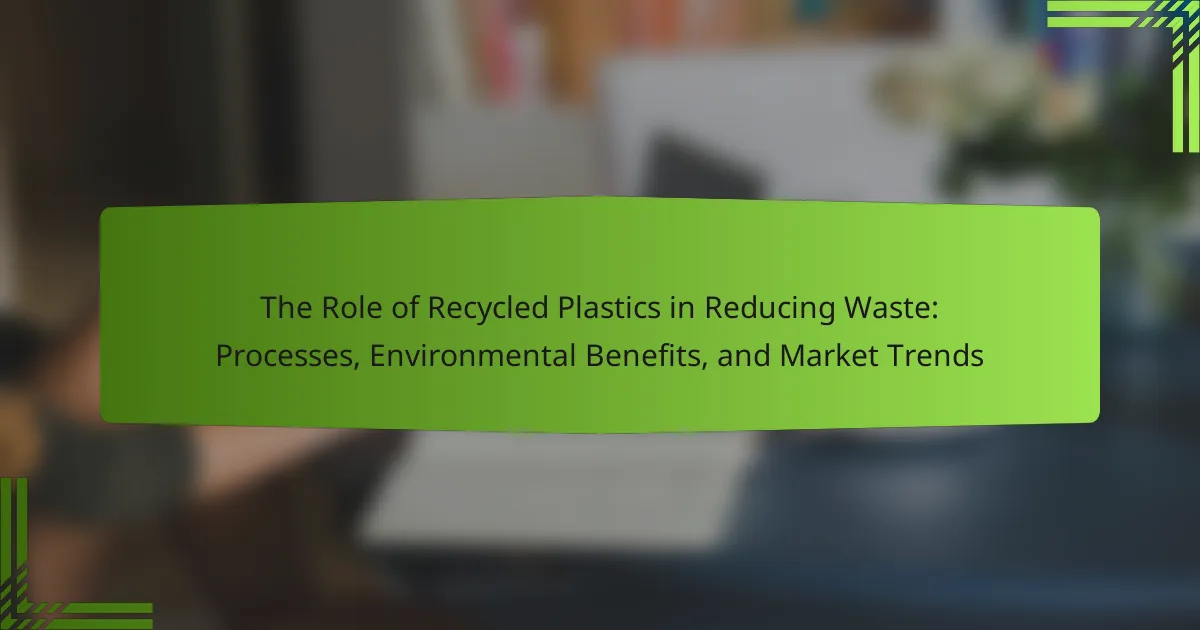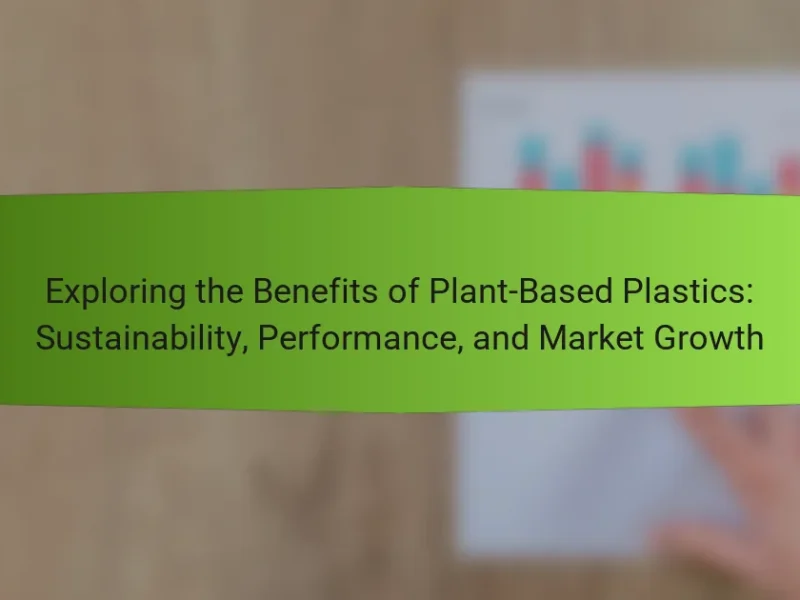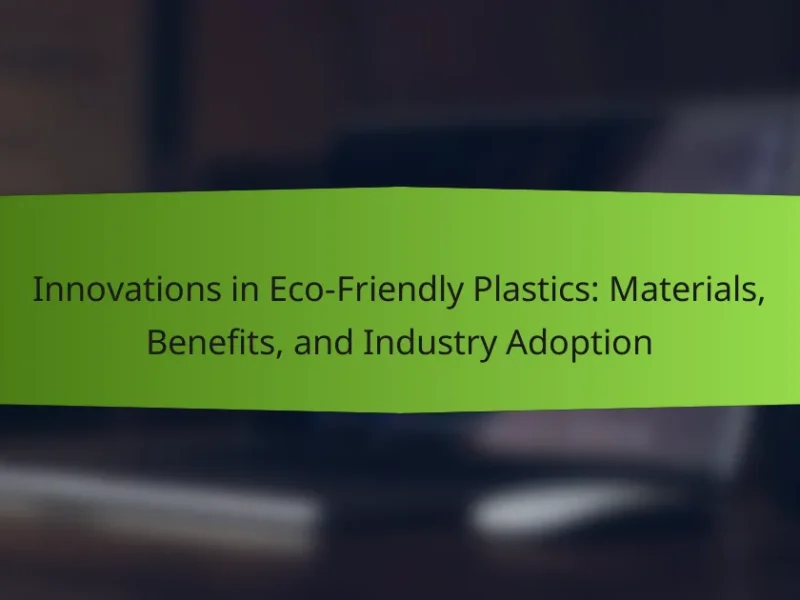Recycled plastics are materials that have been processed to divert waste from landfills and reduce the demand for virgin plastics. This article explores the processes involved in recycling plastics, highlighting their environmental benefits, such as decreased greenhouse gas emissions and energy conservation. It also discusses the significant impact of recycling on landfill space, with one ton of recycled plastic saving approximately 7.4 cubic yards. Furthermore, the article examines market trends related to recycled plastics and their contribution to a circular economy, emphasizing sustainability and resource efficiency.

What is the role of recycled plastics in reducing waste?
Recycled plastics play a crucial role in reducing waste by diverting materials from landfills. They help decrease the demand for virgin plastic production, which is resource-intensive. Recycling plastics reduces greenhouse gas emissions associated with manufacturing new plastics. It also conserves energy, as recycling typically requires less energy than producing new plastic. According to the Environmental Protection Agency, recycling one ton of plastic can save approximately 7.4 cubic yards of landfill space. Additionally, recycled plastics can be transformed into new products, further extending their lifecycle. This process contributes to a circular economy, promoting sustainability and resource efficiency.
How do recycled plastics contribute to waste management?
Recycled plastics significantly contribute to waste management by reducing the volume of plastic waste in landfills. They are processed and transformed into new products, which minimizes the need for virgin materials. This process conserves natural resources and reduces energy consumption. For instance, recycling one ton of plastic can save up to 7.4 cubic yards of landfill space. Additionally, recycling plastics helps decrease greenhouse gas emissions. The Environmental Protection Agency reported that recycling plastics can reduce emissions by approximately 1.17 tons of carbon dioxide equivalent per ton of plastic recycled. Overall, the recycling of plastics plays a crucial role in sustainable waste management practices.
What are the key processes involved in recycling plastics?
The key processes involved in recycling plastics include collection, sorting, cleaning, shredding, and reprocessing. Collection involves gathering plastic waste from various sources like households and businesses. Sorting is the process of separating plastics by type and color to ensure quality. Cleaning removes contaminants such as labels and residues from the plastics. Shredding breaks down the plastics into smaller pieces for easier handling. Reprocessing involves melting and reforming the shredded plastics into new products. According to the Environmental Protection Agency, recycling plastics can significantly reduce landfill waste and conserve resources.
How does the recycling process impact the quality of recycled plastics?
The recycling process significantly impacts the quality of recycled plastics. During recycling, plastics are sorted, cleaned, and processed into new materials. Contaminants and impurities can reduce the integrity of the final product. Recycled plastics often exhibit lower mechanical properties compared to virgin plastics. This degradation occurs due to repeated heating and processing cycles. Studies show that the tensile strength of recycled plastics can decrease by up to 50%. The type of plastic and its previous usage also influence quality. For instance, PET plastics maintain better quality after recycling than polyolefins. Overall, the recycling process can compromise the quality of recycled plastics, necessitating careful management to optimize outcomes.
Why is reducing plastic waste important for the environment?
Reducing plastic waste is crucial for the environment because it minimizes pollution and conserves natural resources. Plastics contribute significantly to land and ocean pollution, harming wildlife and ecosystems. Approximately 8 million tons of plastic enter oceans each year, affecting marine life and ecosystems. Furthermore, plastic production is resource-intensive, requiring fossil fuels and energy. By reducing plastic waste, we decrease greenhouse gas emissions associated with production and disposal. Recycling plastics can save up to 66% of energy compared to producing new plastics. Therefore, reducing plastic waste supports environmental sustainability and protects biodiversity.
What are the environmental benefits of using recycled plastics?
Recycled plastics significantly reduce environmental impact. They decrease the demand for virgin plastic production. This leads to lower greenhouse gas emissions. For instance, recycling one ton of plastic can save up to 1,000-2,000 gallons of gasoline. Additionally, using recycled plastics conserves natural resources. It reduces the need for fossil fuels and decreases energy consumption. Moreover, recycling minimizes landfill waste. In the U.S., about 27 million tons of plastic waste are generated annually. Utilizing recycled plastics can help divert a substantial portion of this waste from landfills. Overall, the environmental benefits of recycled plastics are crucial for sustainable development.
How do recycled plastics help in conserving natural resources?
Recycled plastics help in conserving natural resources by reducing the need for virgin materials. The recycling process reuses existing plastic, which lessens the demand for petroleum, the primary raw material for plastic production. This reduction in demand leads to decreased extraction of fossil fuels. According to the EPA, recycling one ton of plastic can save approximately 7.4 cubic yards of landfill space. Additionally, recycling plastics can save energy; it takes 66% less energy to produce recycled plastic than new plastic. This energy conservation further contributes to lowering greenhouse gas emissions. Thus, recycled plastics play a crucial role in preserving natural resources through resource efficiency and energy savings.
What are the current market trends regarding recycled plastics?
The current market trends regarding recycled plastics indicate a significant increase in demand and innovation. In 2023, the global recycled plastics market was valued at approximately $36 billion. This value is projected to grow at a compound annual growth rate (CAGR) of 10% through 2030. Companies are increasingly adopting sustainable practices, driven by consumer demand for eco-friendly products. The automotive and packaging sectors are leading in the adoption of recycled plastics. Governments are implementing stricter regulations on plastic waste, enhancing the market for recycled materials. Advanced recycling technologies are emerging, improving the quality and range of recycled plastics. Collaboration among industry stakeholders is fostering innovation and expanding recycling capacity. Overall, the market is shifting towards a circular economy model, focusing on sustainability and resource efficiency.
How has the demand for recycled plastics changed over recent years?
The demand for recycled plastics has significantly increased over recent years. This rise is driven by growing environmental awareness and regulations. In 2020, the global recycled plastics market was valued at approximately $37 billion. It is projected to reach $70 billion by 2027, reflecting a compound annual growth rate of around 10%. Companies are increasingly incorporating recycled materials into their products. For instance, major brands have committed to using recycled plastics in packaging. This trend aligns with sustainability goals and consumer preferences for eco-friendly products. The shift towards a circular economy further supports this demand increase.
What industries are leading in the adoption of recycled plastics?
The packaging, automotive, and construction industries are leading in the adoption of recycled plastics. The packaging industry utilizes recycled plastics for bottles, containers, and flexible packaging. This sector is driven by consumer demand for sustainable materials. The automotive industry incorporates recycled plastics in parts such as bumpers and interior components. This reduces weight and improves fuel efficiency. The construction industry uses recycled plastics in products like insulation and piping. This practice supports sustainability goals and reduces landfill waste. These industries collectively showcase the growing trend of integrating recycled plastics into their operations.
How do recycled plastics compare to virgin plastics in terms of sustainability?
Recycled plastics are generally more sustainable than virgin plastics. The production of recycled plastics uses less energy, reducing greenhouse gas emissions by up to 70%. Additionally, recycling diverts waste from landfills, which helps minimize environmental impact. Virgin plastics require significant fossil fuel extraction and processing, contributing to resource depletion. Studies show that recycling one ton of plastic can save approximately 7.4 cubic yards of landfill space. Furthermore, using recycled materials conserves natural resources and reduces the overall carbon footprint. In summary, recycled plastics present a more sustainable option than virgin plastics due to lower energy consumption, reduced emissions, and effective waste management.
What are the cost implications of using recycled plastics versus new plastics?
Using recycled plastics typically offers lower costs compared to new plastics. The production of recycled plastics often requires less energy and fewer raw materials. For instance, recycling plastic can save up to 60% of energy compared to producing new plastic. Additionally, the cost of acquiring recycled materials is generally lower than that of virgin materials. Market demand for recycled plastics is increasing, which can lead to more competitive pricing. However, the initial investment in recycling technology can be high. Overall, the cost implications favor recycled plastics in many scenarios, especially as technology advances.
What challenges exist in the recycling of plastics?
Recycling plastics faces several significant challenges. One major issue is contamination, where non-recyclable materials mix with recyclables. This reduces the quality of recycled plastics and complicates processing. Another challenge is the variety of plastic types, each requiring different recycling methods. Many recycling facilities lack the capability to process all types effectively. Additionally, the economic viability of recycling is often hindered by fluctuating market prices for recycled materials. This leads to inconsistent demand and investment in recycling infrastructure. Public awareness and participation in recycling programs also remain low, affecting collection rates. Lastly, the degradation of plastic quality during recycling limits the number of times plastics can be recycled.
How can these challenges be overcome to enhance recycling efforts?
To enhance recycling efforts, improving public awareness and education is essential. Many individuals lack understanding of what can be recycled. Educational programs can increase participation rates significantly. Implementing convenient recycling systems also plays a crucial role. Accessible bins and clear labeling encourage proper disposal.
Collaboration with businesses can further drive recycling initiatives. Partnerships can lead to innovative recycling technologies. Investing in advanced sorting technologies improves material recovery rates. Research indicates that better sorting can increase recycling efficiency by up to 30%.
Incentives for consumers and businesses can motivate participation. Financial rewards for recycling can boost engagement. Additionally, government policies supporting recycling infrastructure are vital. Legislation can create a more favorable environment for recycling.
Overall, a multifaceted approach combining education, accessibility, technology, and incentives can effectively overcome challenges in recycling efforts.
What best practices can businesses adopt to incorporate recycled plastics?
Businesses can adopt several best practices to incorporate recycled plastics effectively. First, they should evaluate their supply chain for opportunities to source recycled materials. This can involve partnering with suppliers who specialize in recycled plastics. Second, companies should invest in technology for processing recycled plastics. Advanced recycling technologies can enhance the quality of recycled materials. Third, businesses must educate their teams on the benefits of using recycled plastics. This can foster a culture of sustainability within the organization. Fourth, companies should set measurable sustainability goals. These goals can track progress in using recycled materials. Lastly, businesses can engage consumers by promoting products made from recycled plastics. This can enhance brand loyalty and raise awareness of sustainability efforts. According to the National Recycling Coalition, businesses that incorporate recycled materials can significantly reduce their carbon footprint.
The primary entity of this article is recycled plastics, which play a vital role in reducing waste and promoting sustainability. The article explores the processes involved in recycling plastics, including collection, sorting, and reprocessing, as well as the environmental benefits such as reduced greenhouse gas emissions and conservation of natural resources. It also highlights current market trends, showing a significant increase in demand for recycled plastics across various industries, and discusses the challenges faced in recycling efforts, along with best practices for businesses to adopt. Overall, the content emphasizes the importance of recycled plastics in effective waste management and their contribution to a circular economy.


